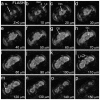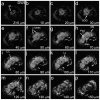Visualization of synaptic domains in the Drosophila brain by magnetic resonance microscopy at 10 micron isotropic resolution
- PMID: 25753480
- PMCID: PMC4649768
- DOI: 10.1038/srep08920
Visualization of synaptic domains in the Drosophila brain by magnetic resonance microscopy at 10 micron isotropic resolution
Abstract
Understanding the complex architecture, connectivity, and pathology of the human brain is a major application of magnetic resonance imaging (MRI). However, the cellular basis of MR signal is still poorly understood. The advent of MR microscopy (MRM) enables imaging biological samples at cellular resolution, helping to interpret the nature of MR signal at the cellular level. In this regard, the small Drosophila brain can reveal key aspects of MR signal through the visualization of complex, intact neuronal structures in their native spatial arrangement. Applying state-of-the-art MR technology, we imaged fixed Drosophila heads at 10 μm isotropic resolution by two endogenously contrasted MRM sequences. The improved MRM sensitivity described here delivered the highest 3D resolution of an intact animal head reported so far. 3D fast low angle shot (FLASH) revealed strong signal in most internal tissues, particularly in the brain cortex, which contains the cell bodies of neurons and glia. Remarkably, 3D diffusion weighted imaging (DWI) delivered unprecedented contrast within the modular brain neuropil, revealing hyperintense signal in synapse-rich microdomains. Thus, the complex Drosophila brain revealed unknown features of FLASH and DWI with potential applications in characterizing the structure and pathology of the mammalian brain.
Figures








Similar articles
-
Investigation of the subcellular architecture of L7 neurons of Aplysia californica using magnetic resonance microscopy (MRM) at 7.8 microns.Sci Rep. 2015 Jun 10;5:11147. doi: 10.1038/srep11147. Sci Rep. 2015. PMID: 26059695 Free PMC article.
-
Visualization of mouse barrel cortex using ex-vivo track density imaging.Neuroimage. 2014 Feb 15;87:465-75. doi: 10.1016/j.neuroimage.2013.09.030. Epub 2013 Sep 21. Neuroimage. 2014. PMID: 24060319
-
Magnetic resonance microscopy of human and porcine neurons and cellular processes.Neuroimage. 2012 Apr 2;60(2):1404-11. doi: 10.1016/j.neuroimage.2012.01.050. Epub 2012 Jan 14. Neuroimage. 2012. PMID: 22281672 Free PMC article.
-
Histology by magnetic resonance microscopy.Magn Reson Q. 1993 Mar;9(1):1-30. Magn Reson Q. 1993. PMID: 8512830 Review.
-
Current technological advances in magnetic resonance with critical impact for clinical diagnosis and therapy.Invest Radiol. 2013 Dec;48(12):869-77. doi: 10.1097/01.rli.0000434380.71793.d3. Invest Radiol. 2013. PMID: 24126386 Review.
Cited by
-
LYNSU: automated 3D neuropil segmentation of fluorescent images for Drosophila brains.Front Neuroinform. 2024 Jul 29;18:1429670. doi: 10.3389/fninf.2024.1429670. eCollection 2024. Front Neuroinform. 2024. PMID: 39135968 Free PMC article.
-
Organization of descending neurons in Drosophila melanogaster.Sci Rep. 2016 Feb 3;6:20259. doi: 10.1038/srep20259. Sci Rep. 2016. PMID: 26837716 Free PMC article.
-
Low-temperature magnetic resonance imaging with 2.8 μm isotropic resolution.J Magn Reson. 2018 Feb;287:47-55. doi: 10.1016/j.jmr.2017.12.016. Epub 2017 Dec 20. J Magn Reson. 2018. PMID: 29288890 Free PMC article.
-
In vivo three-dimensional magnetic resonance imaging of rat knee osteoarthritis model induced using meniscal transection.J Orthop Translat. 2015 Jun 23;3(3):134-141. doi: 10.1016/j.jot.2015.06.002. eCollection 2015 Jul. J Orthop Translat. 2015. PMID: 30035050 Free PMC article.
-
An optimized workflow for microCT imaging of formalin-fixed and paraffin-embedded (FFPE) early equine embryos.Anat Histol Embryol. 2022 Sep;51(5):611-623. doi: 10.1111/ahe.12834. Epub 2022 Jul 18. Anat Histol Embryol. 2022. PMID: 35851500 Free PMC article.
References
-
- Lauterbur P. C. Image formation by induced local interactions: examples employing nuclear magnetic resonance. Nature 242, 190–191 (1973). - PubMed
-
- Eccles C. & Callaghan P. High resolution imaging: the NMR microscope. J Magn Reson 68, 393–398 (1986).
-
- Johnson G., Thompson M. G., L. S. & Hayes C. Nuclear magnetic resonance imaging at microscopic resolution. J Magn Reson 68, 129–137 (1986).
Publication types
MeSH terms
Grants and funding
LinkOut - more resources
Full Text Sources
Other Literature Sources
Medical
Molecular Biology Databases

